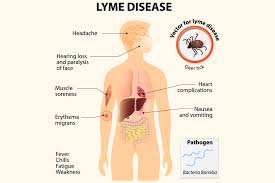Lyme disease is an infectious disease caused by the bacteria Borrelia burgdorferisensu lato. B. burgdorferi is transmitted to humans by a bite from an infected black-legged or deer tick. The tick becomes infected after feeding on infected deer or mice.
A tick has to be present on the skin for 24 to 48 hours to transmit the infection. Most people with Lyme disease have no memory of a tick bite.
Lyme disease occurs in three stages: early localized, early disseminated, and late disseminated. The symptoms you experience will depend on which stage the disease is in.
Stage 1: Early localized disease
Symptoms of Lyme disease start one to two weeks after the tick bite. One of the earliest signs is a “bull’s-eye” rash, which is a sign that bacteria are multiplying in the bloodstream. The rash occurs at the site of the tick bite as a central red spot surrounded by a clear spot with an area of redness at the edge. It may be warm to the touch, but it isn’t painful and doesn’t itch. This rash will disappear after four weeks.The rash is typically called as erythema migrans.
Stage 2: Early disseminated Lyme disease
Early disseminated lyme disease occurs several weeks after the tick bite. During this stage bacteria are beginning to spread throughout the body.
Stage 3: Late disseminated Lyme disease
Late disseminated Lyme disease occurs when the infection hasn’t been treated in stages 1 and 2. Stage 3 can occur weeks, months, or years after the tick bite
Lyme disease is best treated in the early stages. Early treatment is a simple 14 to 21 day course of oral antibiotics to eliminate all traces of infection. Medications used to treat Lyme disease include:






